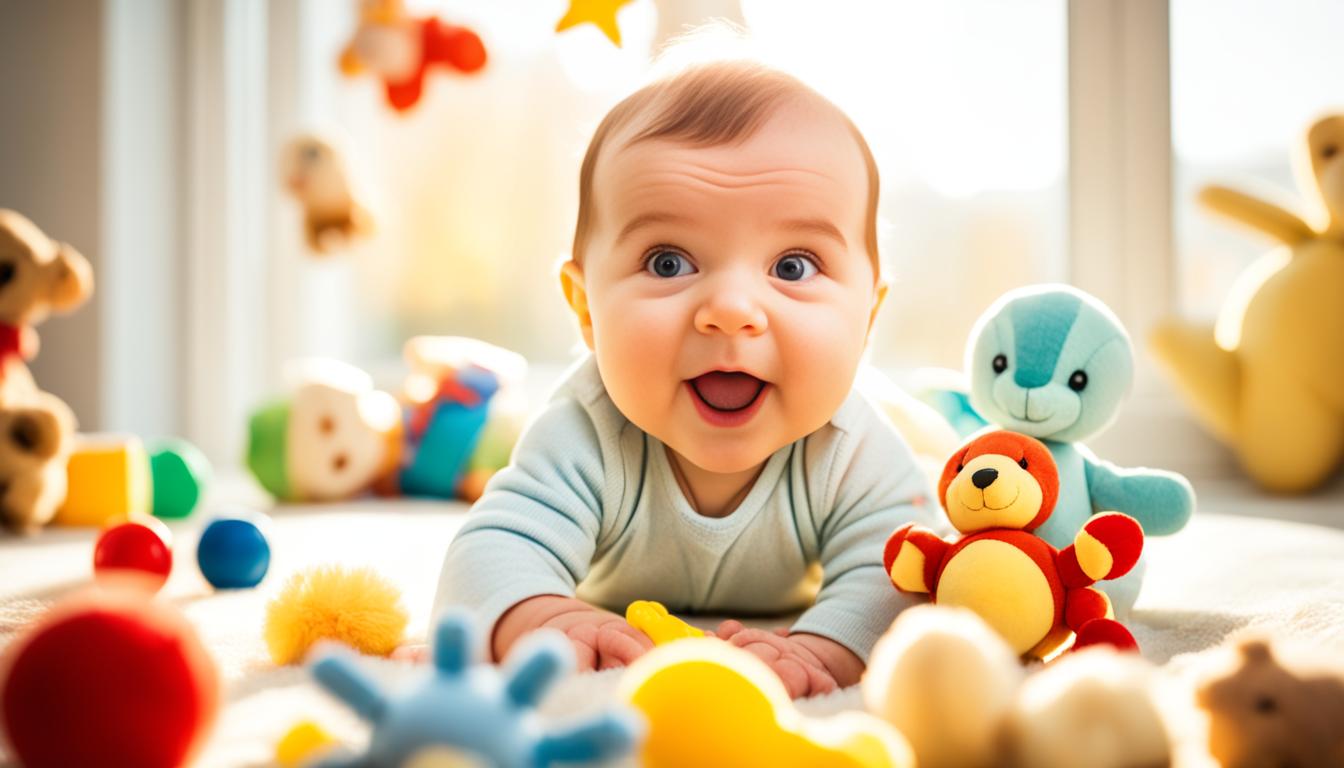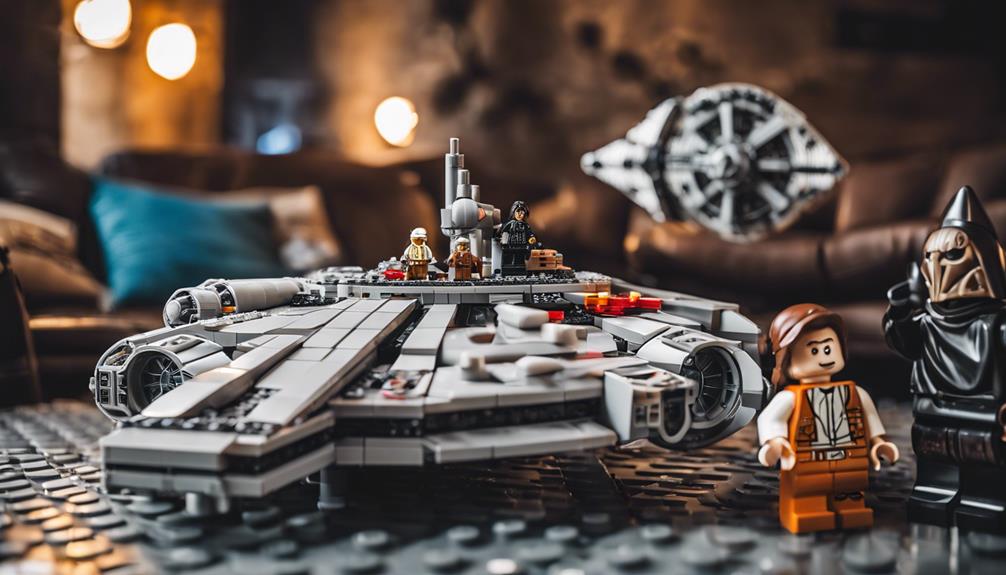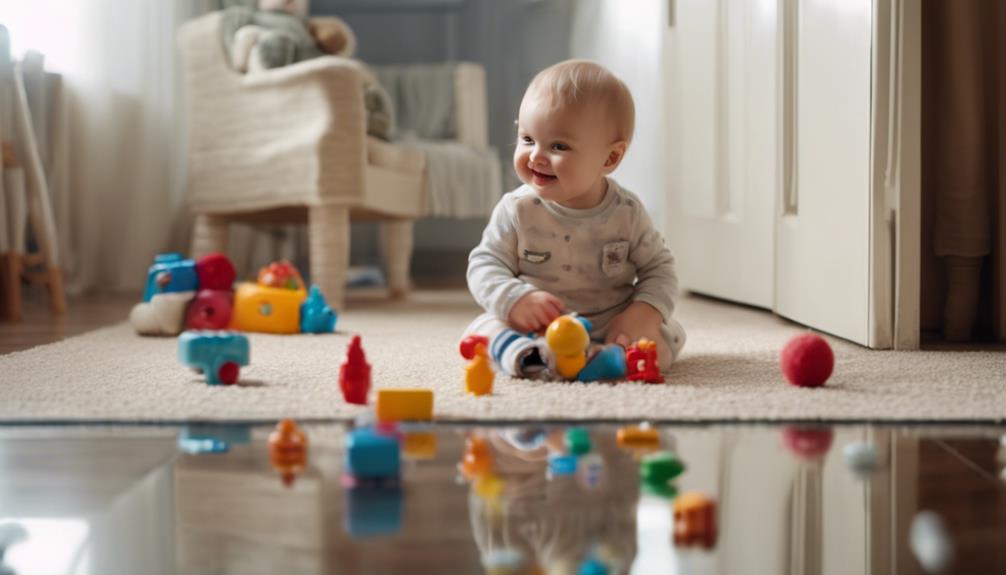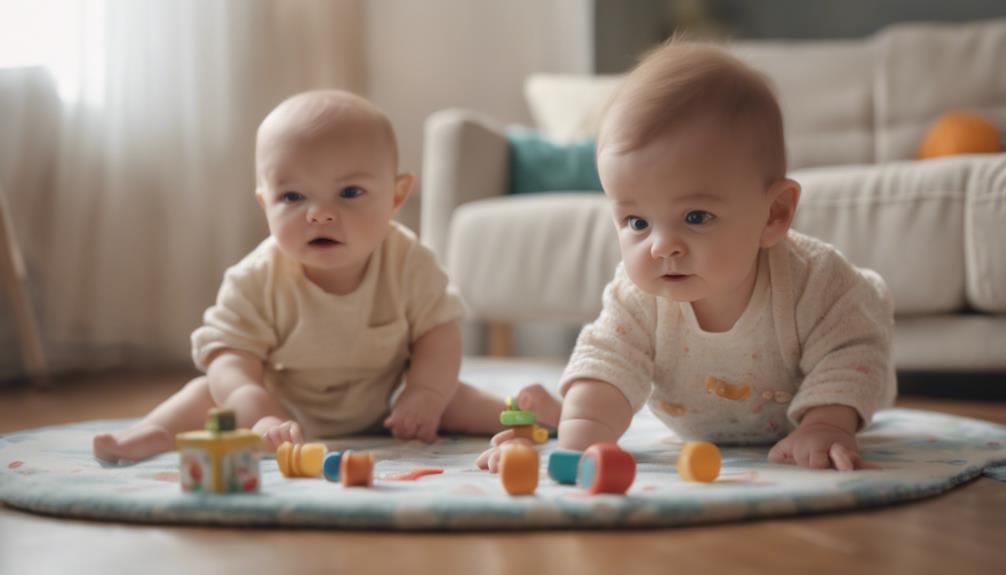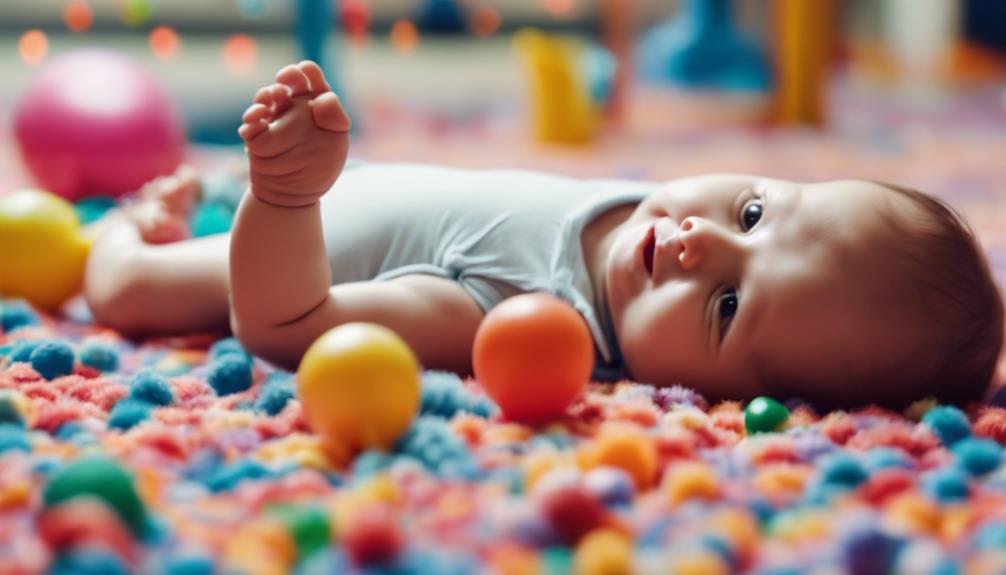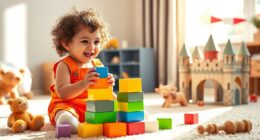Picture yourself in a comfortable living room, enveloped by the calming sounds of nature, the gentle feel of a soft blanket, and the subtle aroma of lavender drifting through the air. As you unwind and absorb these sensory stimuli, you experience a feeling of peace and satisfaction. Consider how these sensory experiences could influence the growth of a newborn baby.
From the moment a baby is born, their senses are constantly bombarded with new stimuli that shape their understanding of the world. Sensory development in infants is a crucial aspect of their overall growth and learning. By providing sensory stimulation and engaging activities, you can enhance your baby’s sensory development in their early years, setting a strong foundation for future learning and healthy development1.
Infants are like sponges, absorbing everything they see, hear, touch, taste, and smell. Each sensory experience plays a vital role in neuronal development, helping to establish neural pathways and strengthen connections between the brain and the body. Early implementation of sensory activities can promote overall sensory and motor development in infants and toddlers, providing a vital foundation for future learning, healthy social lives, and motor skills development1.
So, how can you boost your baby’s sensory development? Here are some essential tips based on research and expert recommendations to support your little one’s sensory growth:
Key Takeaways:
- Engaging in sensory activities can promote overall sensory and motor development in infants and toddlers, providing a vital foundation for future learning, healthy social lives, and motor skills development1.
- Creating a sensory-rich environment with a variety of stimuli can enhance your baby’s sensory development and support their cognitive, motor, and social skills.
- Providing opportunities for safe exploration and sensory experiences is key to fostering sensory development in infants.
- Interacting with your baby through positive and engaging activities strengthens the caregiver-infant bond and supports social development.
- Tummy time is crucial for strengthening postural muscles and promoting overall sensory and motor development in babies2.
- Using open-ended toys can encourage imagination and creativity in infants, fostering their sensory and cognitive development2.
By implementing these tips and incorporating sensory activities into your daily routine, you can provide a rich and nurturing environment that supports your baby’s sensory development. Stay tuned for the following sections where we will dive deeper into each sense and explore specific activities and strategies to boost your baby’s sensory growth.
Importance of Sensory Stimulation for Babies
Sensory stimulation plays a vital role in the development of a baby’s brain and overall well-being. Babies are born with the ability to perceive and respond to various sensory experiences, and by providing them with sensory stimulation, you can support their cognitive, emotional, and motor development. From the moment they are born, babies are processing an incredible amount of sensory information, which helps wire neural connections and promote early learning3.
Research has shown that newborn babies develop 2-3 million synapses each second, aiding in sensory message transmission and brain development3. These synapses form connections that allow different parts of the brain to communicate and process sensory input effectively. It is through these connections that babies learn about their environment and make sense of the world around them.
One important aspect of sensory stimulation is the concept of “Kangaroo care.” This involves skin-to-skin contact between a baby and caregiver for at least an hour daily for two weeks. Studies have shown that this practice leads to improved mental and physical assessment scores lasting for months3. It promotes bonding between the caregiver and the baby while also providing essential sensory input.
Maternal touch and various daily interactions provide significant mechanosensory stimulation to infants, promoting growth and maturation3. Through gentle touches, cuddling, and engaging in activities such as gentle massage, babies receive tactile input that supports their sensory development. These sensory experiences contribute to the formation of neural connections and help babies develop an understanding of their bodies and the world around them.
Sensory system maturation in babies follows a specific order: tactile > vestibular > chemical > auditory > visual3. This means that babies initially rely more on their sense of touch, followed by their sense of balance and motion, and gradually develop their sense of smell, hearing, and vision. By providing sensory experiences that target each of these senses, you can support their sensory development in a progressive manner.
Introducing textured objects, playing in water, engaging in art activities, and offering different foods can promote sensory stimulation in babies3. These activities expose babies to various textures, temperatures, and sensations, allowing them to explore and discover the world around them. Sensory play not only stimulates their senses but also encourages their curiosity and cognitive skills.
Activities such as watching moving objects, playing music, and interacting with colored objects are beneficial for enhancing sensory development in infants3. These experiences engage their auditory and visual senses, helping them recognize different sounds, track objects, and develop their ability to focus and attend to stimuli.
Incorporating sensory stimulation into your baby’s daily routine is essential for their overall development. By providing sensory experiences that align with their age and stage of development, you can support their sensory, cognitive, and motor skills. Remember to monitor their responses and adjust the level of stimulation to avoid overstimulation, as each baby is unique and may have different thresholds for sensory input4.
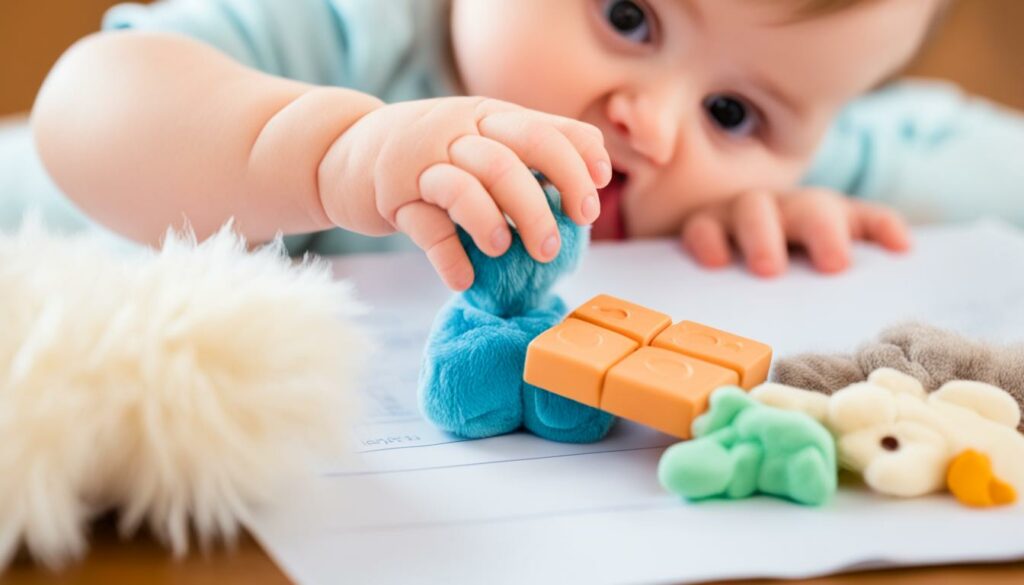
Providing a wide range of positive sensory experiences for babies during their first year of life is essential for their development. From singing and bouncing during the first three months to tummy time and exposure to different textures through fabrics from 3-6 months, each developmental stage brings new opportunities for sensory exploration4.
Parents can have a significant impact on the development of their baby’s brain by offering sensory experiences such as bath time and massage4. These experiences provide tactile and proprioceptive input, supporting their sensory integration and overall well-being. Bath time can be a soothing sensory experience for babies, while gentle massage promotes relaxation and bonding.
As babies reach 6-9 months, sensory experiences can be expanded to include blowing bubbles, playing with cause and effect toys, and exploring their surroundings4. These activities engage their visual and motor skills, helping them understand cause and effect relationships and promoting their curiosity and exploratory behaviors.
Introducing water play, crawling, and exploring various foods are recommended sensory experiences for babies at 9-12 months4. Water play provides tactile and visual stimulation while promoting their motor skills and body awareness. Crawling helps strengthen their muscles and coordination, and offering different foods allows them to experience new tastes, textures, and smells.
While sensory stimulation is essential, it’s important to be mindful of overstimulation. Babies can become overwhelmed if they receive too much sensory input, which may result in fussiness or distress4. Pay attention to your baby’s cues and adjust the level of stimulation accordingly. Every baby is unique, and it’s important to find the right balance that suits their individual needs.
Tips to Stimulate Baby’s Sense of Touch
Touch is one of the primary senses in infants, and providing tactile stimulation is crucial for their sensory development. By incorporating sensory play and engaging activities, you can enhance your baby’s sense of touch and promote overall sensory awareness.
A study suggests that daily interactions such as feeding, playing, carrying, bathing, and changing diapers stimulate key senses in infants, with feeding being the most stimulating activity3. These interactions create opportunities for tactile experiences, allowing babies to explore different textures and sensations.
Playing in water is an excellent way to stimulate a baby’s sense of touch. Fill a shallow tub or basin with warm water and let your baby splash and explore different water toys. The sensation of water on their skin provides tactile input and helps develop their sensory perception35.
Using different textured objects during playtime can also enhance your baby’s sense of touch. Offer toys made of various materials such as soft fabric, textured rattles, or rubber balls. These objects provide different tactile sensations and promote the development of fine motor skills35.
Gentle massage is another effective way to stimulate your baby’s sense of touch. Use gentle strokes and light pressure to massage their arms, legs, and back. Massaging your baby not only promotes bonding but also provides soothing benefits and enhances their sensory awareness6.
Research shows that sensory play with safe substances like foods and flowers can benefit babies’ sensory development3. Allow your baby to touch and explore different textures by introducing materials such as cooked pasta, soft fruits, or petals from flowers. Always ensure that the materials used are safe and age-appropriate for your baby.
To promote sensory stimulation, it is essential to create a safe and engaging environment for your baby. Avoid sharp-edged toys and provide colorful, movable toys that can be easily grasped. These toys encourage exploration and sensory engagement3.
Incorporating sensory play and providing opportunities for tactile stimulation will not only enhance your baby’s sense of touch but also contribute to their overall sensory development. By engaging their senses, you are helping them build important neural pathways and supporting their cognitive, motor, and social skills5.

Enhancing Baby’s Sense of Hearing
Babies have a natural inclination towards sound. Their sense of hearing plays a vital role in their overall sensory development and language acquisition7. To enhance your baby’s sense of hearing, there are various sensory activities and experiences you can provide that stimulate auditory development and support their growing language skills.
Talk and Sing to Your Baby
Talking and singing to your baby is not only a bonding experience but also a way to expose them to different sounds and rhythms. Your voice is familiar and comforting to them, and they begin to recognize it right away7. Engage in conversations, tell stories, and sing songs to help them develop their listening skills and language comprehension.
Play with Sound Rattles
Sound rattles, such as maracas or bells, are excellent toys to engage your baby’s sense of hearing. They provide auditory stimulation as the baby grasps and shakes them, producing different sounds. This activity helps babies recognize and differentiate between various sounds, contributing to their auditory development7.
Expose Your Baby to a Variety of Sounds
Expose your baby to different sounds in their environment. This can include nature sounds, music, household noises, or even the sound of your voice as you engage in daily activities. The brain of a baby is wired to learn and make connections, and exposure to various sounds supports their auditory development7.
By incorporating these sensory activities into your baby’s daily routine, you can enhance their auditory development and help them recognize and respond to different sounds in their environment. Remember, their sense of hearing is an essential aspect of their overall sensory growth and language acquisition.

Enhancing Baby’s Visual Sense
Visual stimulation plays a crucial role in the development of a baby’s visual sense3. By engaging your baby’s vision through various activities, you can support their visual perception and cognitive growth. Here are some sensory activities that can enhance your baby’s visual development:
- Play with mirrors: Use child-safe mirrors to allow your baby to explore their own reflection and track objects3. Mirrors provide visual stimulation and help babies develop self-awareness.
- Use flashlights: Shine a flashlight around the room or on different surfaces to captivate your baby’s attention and encourage visual tracking3. This activity stimulates their visual senses and promotes object recognition.
- Take walks outside: Exposing your baby to different visual stimuli in nature, such as trees, flowers, and colorful surroundings, helps their visual system develop3. Walking outside provides a variety of visual experiences and promotes exploration of their environment.
In addition to these activities, it’s important to note that a baby’s visual development progresses as they grow8. Until around three months of age, babies have limited visual focus, mainly within 8-10 inches from their faces8. Around three months, their range of vision starts to expand, and they engage in visual tracking, following moving objects with their eyes8. Between five to eight months, babies develop depth perception and a more sensitive sense of color vision8. They can also accomplish tasks like moving objects from one hand to the other8. Between nine to 12 months, babies work on using their eyes and hands together, synchronizing their movements8. They should also start feeding themselves finger foods at this stage, further enhancing their visual and motor skills8.
Remember, each baby is different, and their sensory development may vary3. Personalized counseling and adapting activities based on their individual needs and preferences can provide optimal sensory stimulation3. By incorporating these sensory activities into your baby’s daily routine, you can support their visual development and create meaningful sensory experiences.
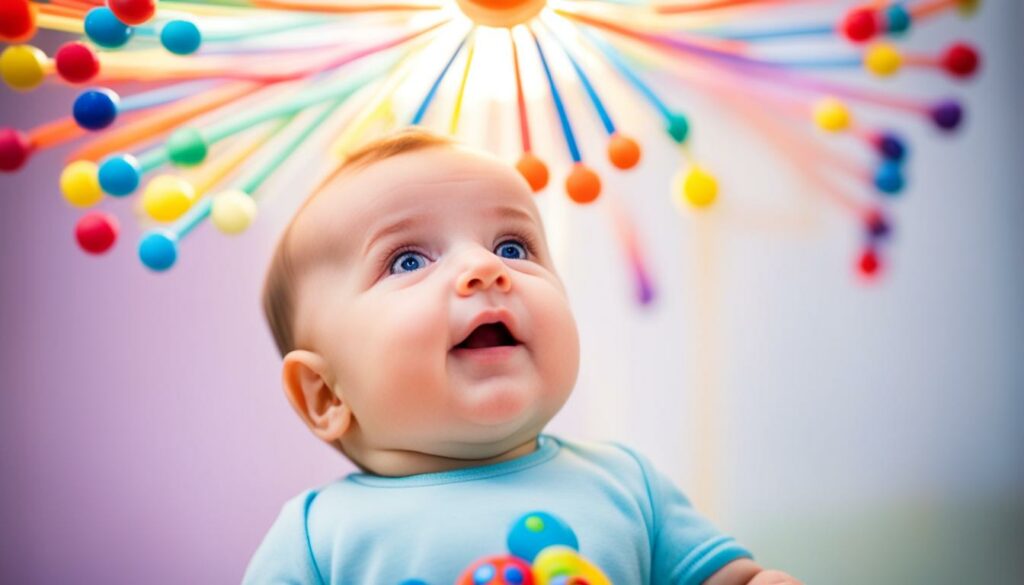
Developing Baby’s Smell and Taste Senses
Smell and taste are important sensory experiences for babies, contributing to their overall sensory development. Newborns have a highly developed sense of smell, recognizing important scents like that of their mother’s breast milk and natural scent.9
To enhance your baby’s sense of smell, you can incorporate sensory activities focused on scents. During bath time, you can use scented lotions to introduce different smells and create a sensory-rich experience.9 Providing scent jars with different scents can also allow your baby to explore and distinguish between various smells.9
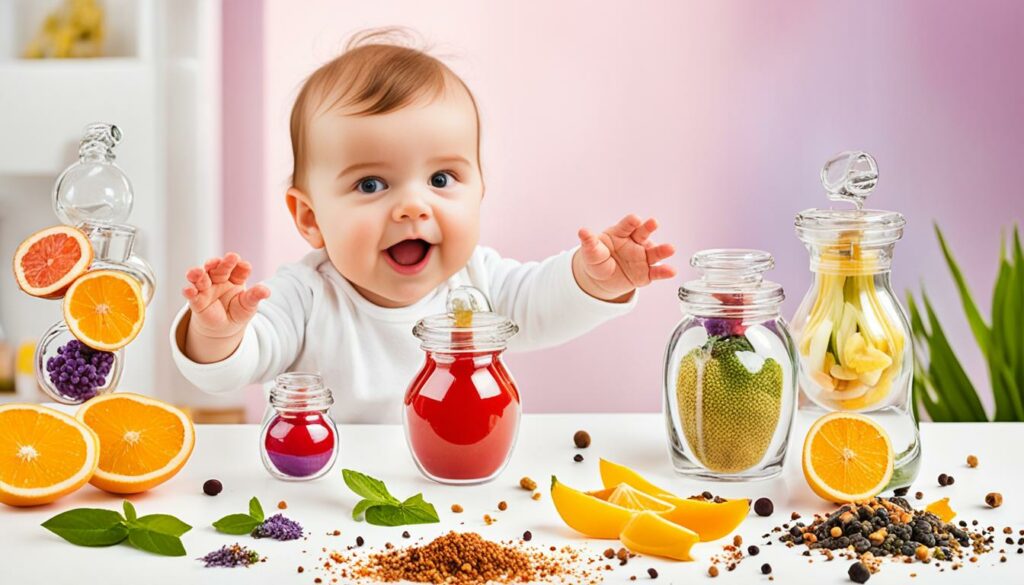
Additionally, your baby’s sense of taste can be developed through sensory play with different tastes and textures. Introduce a variety of flavors in your baby’s food, allowing them to experience the natural inclination towards certain tastes, such as sweetness.10
Creating a safe and stimulating environment for sensory play can further enhance their exploration of smells and tastes.11 Remember that familiar scents, especially from parents, can be very comforting for babies and help in calming them down.9
Sensory activities for smell and taste not only promote your baby’s sensory awareness but also provide opportunities for bonding and emotional connection with you as their caregiver. Enjoy these sensory experiences together as you guide them through their sensory development journey.1011
Developmental Milestones in Smell and Taste
| Age | Developmental Milestones |
|---|---|
| From womb | Babies start using their sense of smell and become familiar with scents early on.9 |
| Birth | Newborns have a highly developed sense of smell, recognizing important scents like their mother’s breast milk.9 |
| 1 month | Babies can differentiate between different smells, including familiar scents like those of parents.9 |
| 3 months | Babies use their sense of smell to distinguish between known individuals and strangers, reacting emotionally to different scents.9 |
| 6 months | Babies use their sense of smell and taste to decide if they like new foods, showing preferences influenced by their exposure in the womb.9 |
| 12 months | Babies may exhibit signs of food preferences based on smell, indicating likes and dislikes through scent perception.9 |
By engaging in sensory activities for smell and taste, you can foster your baby’s development and create meaningful sensory experiences that support their overall growth.
Encouraging Baby’s Movement and Body Awareness
In the early stages of life, movement and body awareness play a crucial role in a baby’s sensory development. By providing opportunities for various movements and engaging in sensory activities, you can support the development of their motor skills, proprioception, and overall spatial awareness.12
Babies naturally explore their environment by rocking, stretching, and moving their bodies. These movements help strengthen their muscles, improve coordination, and refine their motor skills. Encouraging and facilitating their movements can aid in their physical development.12
One way to promote movement and body awareness is by providing opportunities for rocking. This can be done by gently rocking them in your arms or using a rocking chair or cradle. Rocking motions not only soothe babies but also enhance their vestibular system, which is responsible for balance and spatial perception.13
Carrying your baby in different positions can also support their movement and body awareness. Holding them upright helps strengthen their neck and back muscles, while carrying them on your hip or in a sling allows them to experience different sensations and explore their surroundings.13
Gentle stretching exercises can further enhance a baby’s body awareness. Simple stretches, like extending their arms and legs or gently rolling them from side to side, can help enhance their flexibility, body coordination, and promote spatial awareness.13
It’s important to note that each baby develops at their own pace, so it’s crucial to provide a safe and supportive environment that allows them to explore and move freely. By encouraging their movement and body awareness through these activities, you can promote their overall sensory development and help them reach their developmental milestones.1213
| Benefits of Encouraging Baby’s Movement and Body Awareness: |
|---|
| Motor Skills Development: Engaging in various movements helps strengthen baby’s muscles and improve coordination.12 |
| Proprioception: By encouraging movement and body awareness, babies develop a better sense of their body position and movement.12 |
| Spatial Awareness: Providing different movements and positions allows babies to explore their surroundings and enhance their spatial perception.12 |
Remember to always supervise your baby during these activities, ensuring their safety and comfort. With regular practice and support, your baby can develop strong motor skills, proprioception, and body awareness, setting a foundation for their physical and sensory development.12
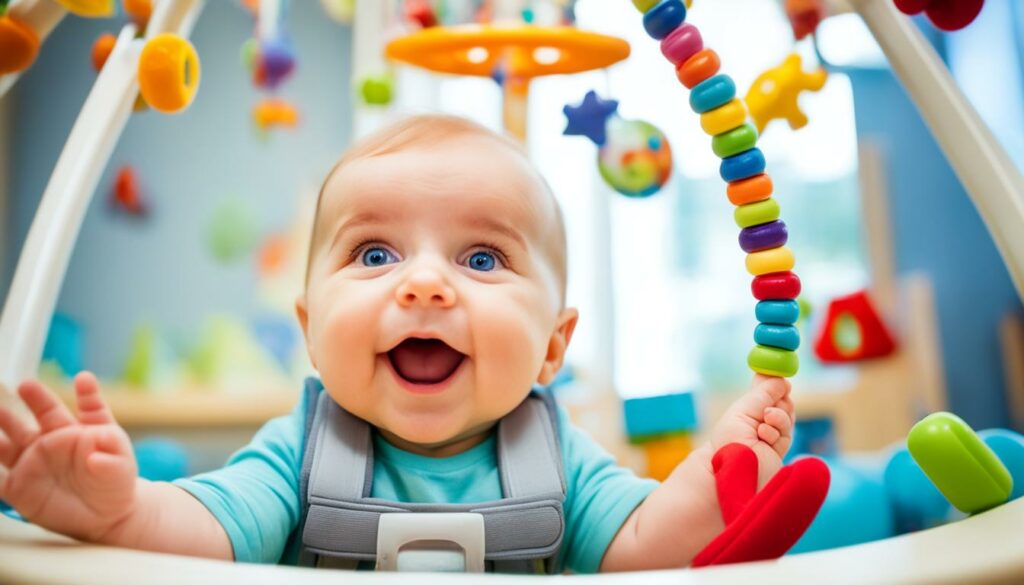
Creating a Safe and Stimulating Environment
When it comes to your baby’s sensory development, providing a safe and stimulating environment is crucial. By creating an environment that encourages exploration and interaction, you can support their overall sensory growth and development. Here are some tips to help you create a sensory-rich environment for your baby:
- Choose toys and objects that allow babies to explore and interact12. Opt for toys with different textures, shapes, and colors to engage their senses and promote sensory awareness.
- Respond promptly to your baby’s cries and needs14. This helps them feel secure, which in turn promotes a positive sensory experience and overall well-being.
- Create a calm and nurturing atmosphere14. Maintain a soothing environment by playing soft music, using dimmed lights, and minimizing loud noises that may overwhelm your baby’s senses.
- Provide opportunities for sensory play both indoors and outdoors12. Sensory play allows babies to explore different textures, sounds, and movements, enhancing their cognitive and physical development.
- Ensure the safety of your baby’s environment by evaluating materials for potential choking hazards14. Follow safety guidelines and supervise your baby during play to prevent accidents and ensure a secure environment.
By following these tips and creating a safe and stimulating environment for your baby, you can support their sensory development and provide them with opportunities for growth and exploration.
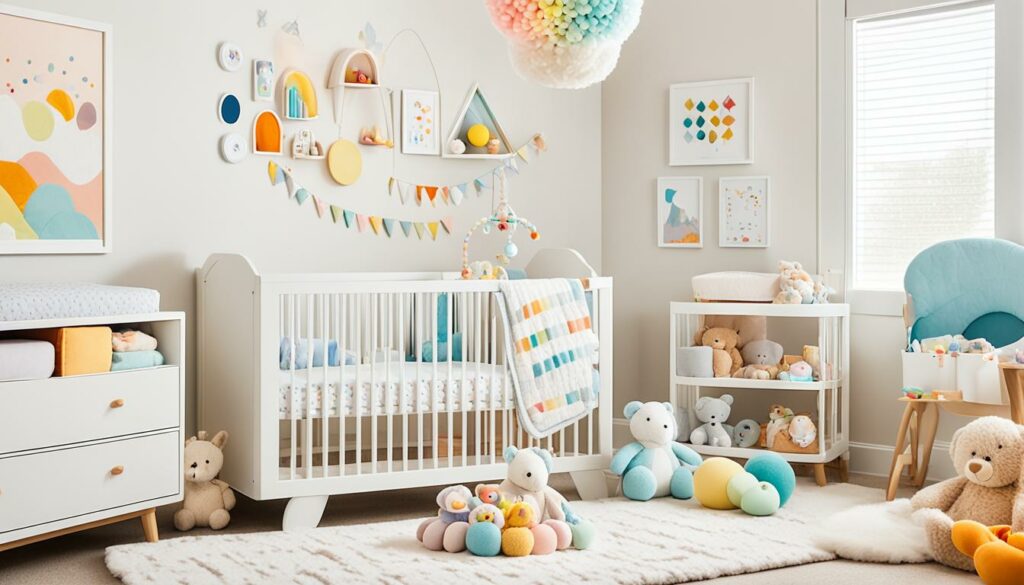
Sensory Toys for Infants
| Toy | Description |
|---|---|
| Tactile Balls | Soft and textured balls that promote tactile stimulation and fine motor skills development. |
| Stacking Blocks | Colorful blocks that encourage hand-eye coordination, spatial awareness, and problem-solving skills. |
| Activity Gym | A playmat with hanging toys and interactive features to stimulate the baby’s senses and encourage exploration. |
| Rattles | Small toys with shaking or rattling sounds that engage the baby’s auditory senses and promote hand-eye coordination. |
| Textured Books | Books with different textures and sensory elements that encourage tactile exploration and early literacy skills. |
Importance of Positive Interaction and Bonding
Positive interaction and bonding with caregivers play a crucial role in a baby’s sensory development. Engaging in activities such as talking, playing, and cuddling not only strengthens the emotional connection between the caregiver and the infant but also supports social development and promotes sensory integration.
Establishing a strong bond through caregiver-infant interaction creates a safe and nurturing environment for the baby to explore their senses. By engaging in positive sensory experiences, the infant can develop their sensory perception and enhance their overall well-being.
Research has shown that early experiences with caregivers are essential for brain wiring, memory formation, and relationship development15. By responding to the baby’s cues, comforting them, and providing sensory stimulation, caregivers promote the development of neural connections and optimize the baby’s sensory growth.
Engaging in sensory bonding activities not only provides sensory stimulation but also contributes to the baby’s cognitive and emotional development. These activities can include gentle touch, holding, singing, and playing interactive games that involve the senses.
Positive caregiver-infant interaction and bonding are particularly important during the first years of life when the brain undergoes significant development and growth. Studies have shown that infants who receive responsive and nurturing care from their caregivers tend to have better developmental outcomes in various domains such as cognitive, social, and emotional development16.
Creating positive sensory experiences and bonding moments with a caregiver not only supports the baby’s sensory development but also fosters a sense of security, trust, and emotional well-being. It lays the foundation for healthy relationships and provides a strong base for future learning and development.
Conclusion
Enhancing sensory development in infants is crucial for their overall growth and learning. By providing sensory stimulation and engaging in activities that target each sense, you can support your baby’s cognitive, motor, and social skills. Research shows that on average, babies are able to hold up their head at 6 weeks old17. Most babies can sit alone at 7 months old, with 90% achieving this milestone between 5 and 9 months old17. Fine motor skills start developing around 4 months of age when an infant can reach for an object17. The pincer grasp, which develops around 9 months of age, allows infants to grasp objects using their forefinger and thumb17.
Additionally, sensory development in infancy has been linked to neural response and sensory seeking behaviors18. Individual variation in sensory seeking is influenced by optimal stimulation, processing speed, and information prioritization18. Cognitive ability and the prioritization of incoming information also play a role in sensory seeking18. Creating a safe and stimulating environment for your baby, with positive interaction and bonding, is essential for their sensory development19.
The development of the sense of touch begins early in gestation, with sensory receptors developing in the face and progressing to other parts of the body19. Babies can appreciate a range of sensations, including pain, in the mid-third trimester19. They prefer their mother’s voice shortly after birth and can even show preferences for certain tastes they were exposed to in the womb19. Although sensory development continues after birth, early exposure to sensory stimuli can impact postnatal development19.
FAQ
What is sensory development in infants?
Why is sensory development important for infants?
How can I stimulate my baby’s sense of touch?
What can I do to enhance my baby’s sense of hearing?
How can I boost my baby’s visual sense?
How can I develop my baby’s smell and taste senses?
How can I encourage my baby’s movement and body awareness?
What should I consider when creating a safe and stimulating environment for my baby?
Why is positive interaction and bonding important for my baby’s sensory development?
How can I support my baby’s sensory development?
Source Links
- https://harkla.co/products/infant-sensory-development-course
- https://hellobrella.com/7-tips-to-boost-your-babys-development/
- https://www.news-medical.net/health/Importance-of-Sensory-Stimulation-for-Babies.aspx
- https://health.choc.org/the-importance-of-early-sensory-experiences-in-development/
- https://www.procaresoftware.com/blog/list-of-sensory-activities-for-infants-toddlers/
- https://www.babycenter.com/baby/baby-development/baby-sensory-development-touch_10401108
- https://montessorigeneration.com/blogs/montessori/sensory-development-with-montessori-toys-for-babies
- https://www.canr.msu.edu/news/infant_vision_development_helping_babies_see_their_bright_futures
- https://www.babycenter.com/baby/baby-development/baby-sensory-development-smell_10401106
- https://www.stanfordchildrens.org/en/topic/default?id=newborn-senses-90-P02631
- https://www.chop.edu/conditions-diseases/newborn-senses
- https://www.virtuallabschool.org/infant-toddler/physical-development/lesson-3
- https://www.aboutkidshealth.ca/sensory-development-and-suggestions-for-babies-the-first-18-months
- https://extension.psu.edu/programs/betterkidcare/early-care/tip-pages/all/infant-environments-lets-take-a-closer-look
- https://www.ncbi.nlm.nih.gov/pmc/articles/PMC5330336/
- https://www.ncbi.nlm.nih.gov/pmc/articles/PMC8522805/
- https://courses.lumenlearning.com/wm-lifespandevelopment/chapter/motor-and-sensory-development/
- https://www.ncbi.nlm.nih.gov/pmc/articles/PMC7496506/
- https://utswmed.org/medblog/sensory-development-utero/

